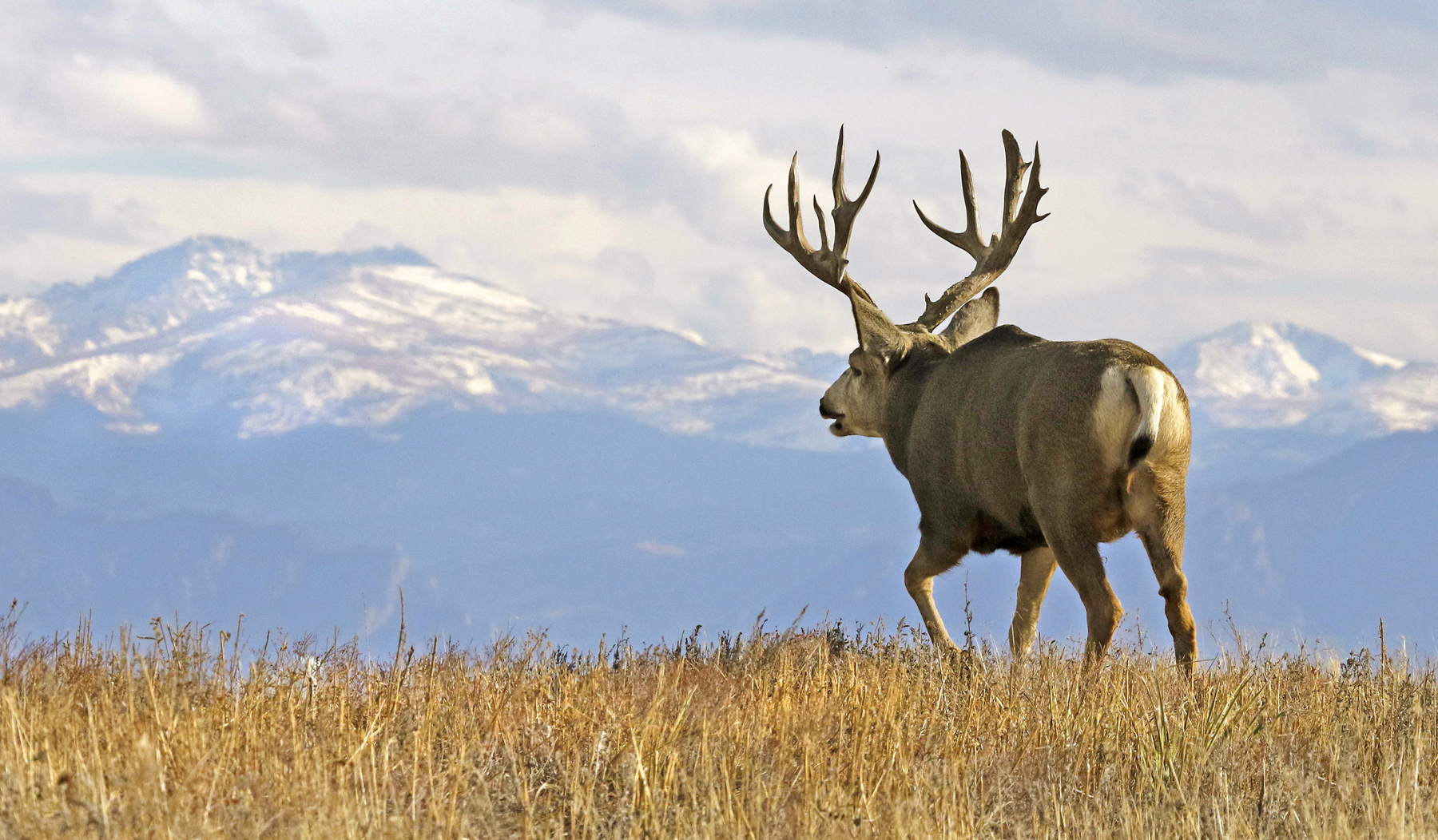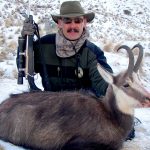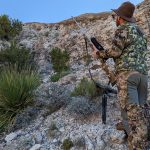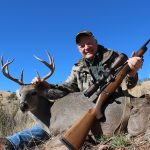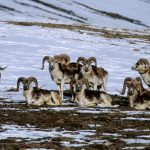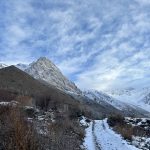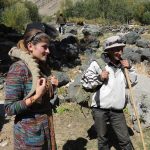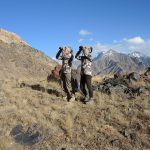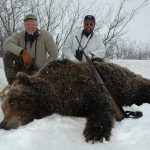The biggest bucks live in the highest, loneliest places.
Photo above by Vic Schendel
After spending about half my autumn hunting time pursuing mule deer from Sonora to Alberta over the past several decades, I started to envision mule deer range as a loose ocean of deer, filling the western portion of the Mississippi River’s huge basin. Their present range, in fact, pretty much covers the same area as the shallow inland sea that rose during the much warmer climate of the Cretaceous Period. The ocean metaphor occurred to me partly because I have found many aquatic fossils in much of Montana’s mule deer country, sandstone squids and snails along high-plains ridges, and shiny trilobites trapped in mountain shale.
Mule deer are sparse along the high western shoreline of the mule deer ocean, the Rocky Mountains—sometimes so scarce hunters may search for days without seeing a buck. But mountain bucks are among the biggest, which is why they keep drawing some of us back, again and again.
Sometimes mountain mule deer hunters end up glassing huge valleys devoid of any other trace of humanity, evoking the pleasant conceit that we’re somehow much closer to Nature. Looking down on flying eagles can do that, and if we look patiently enough, a gray-brown buck may eventually appear, often long after dawn or before dusk, because in high wilderness they’re not as worried about human predators.
The biggest mountain mule deer I’ve ever killed, both in body and antler, ambled into sight about 10 o’clock in the morning, when wise old bucks should be in bed, on a half-barren limestone ridge partially created by that inland sea. A Forest Service map indicated the ridge was twenty miles from the nearest trailhead, and the buck strolled along as casually as a window-shopper, pausing now and then to bite a stringy tuft of “beard” lichen from a stunted subalpine fir.
I rather noisily dismounted from my horse, pulled my rifle from its scabbard, then rested the fore-end on a fir branch. At the shot, the buck collapsed on a bed of limestone cobbles, and his body turned out to be so big his antlers were even larger than I had first thought.
Exactly what that buck weighed I do not know, but I did measure his body, an odd compulsion learned from field work as a biology major. The buck turned out to be just about as large as a 1 1/2-year-old cow elk my wife got a couple weeks later–and a high-plains mule deer buck I killed in Alberta 15 years later. The boned meat from the Canadian buck weighed a little over 130 pounds, and a general rule for big game is the boned meat weighs about a third as much as the entire animal.
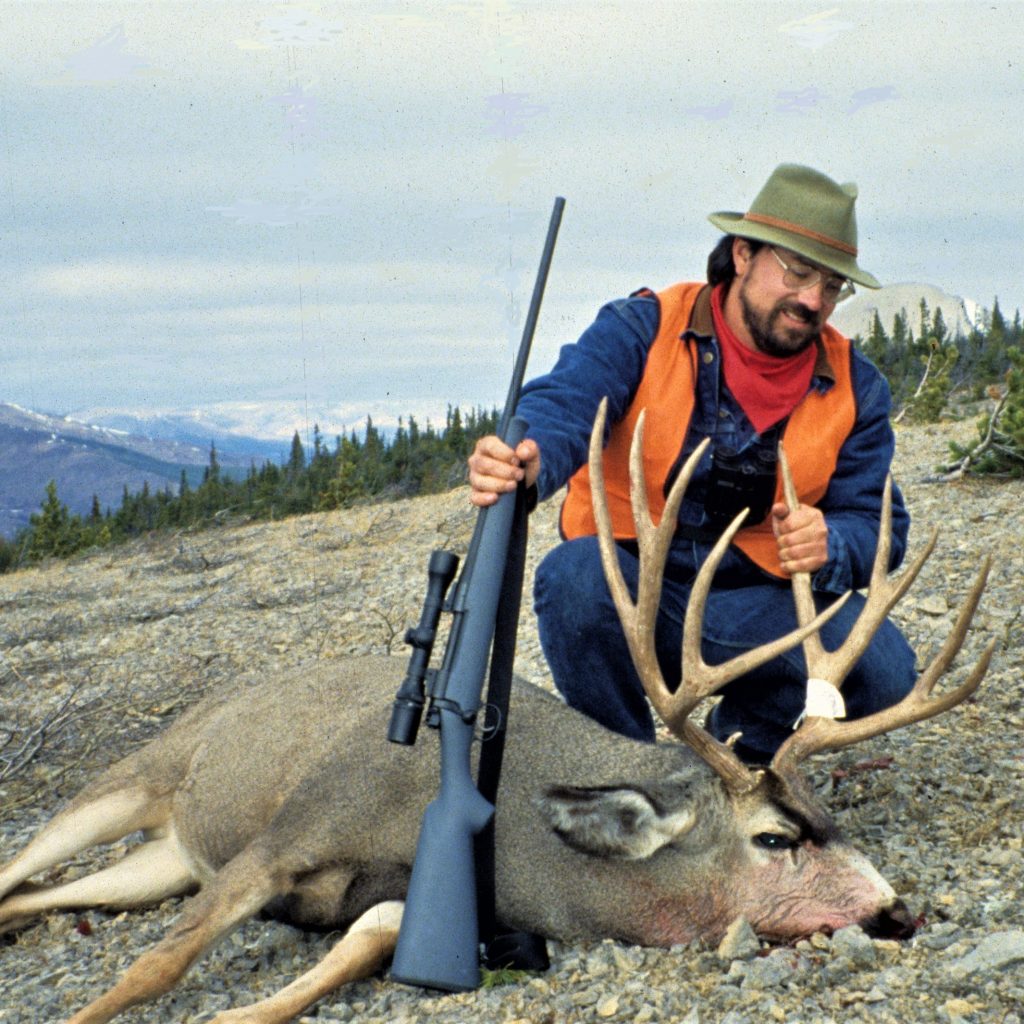
High-country mule deer tend to be bigger than plains bucks, which might be due to the biological rule postulated by German biologist Carl Bergmann in 1847 that warm-blooded animals tend to grow larger in colder environments, due to larger bodies having less relative surface area, thus retaining more heat. But like any general biological rule, there are exceptions—and objections—to Bergmann’s Rule.
Well-known Canadian biologist Valerius Geist believes larger body size is instead related to food availability during the growing season. This would seem to be odd in the high Rockies, but up there vegetation usually remains at least somewhat green (and hence more nutritious) from spring through early fall, due to more summer precipitation and less evaporation than in the warmer valleys below. What I do know is the mountain bucks my hunting partners and I have taken often had very large bodies and, if old enough, antlers to match—although there are exceptions to that as well.
Plus, while mountain mule deer can be found up among bighorn sheep, and sometimes close to mountain goats, they normally don’t winter that high. Instead, they move downhill as snow deepens in late fall—though big bucks will often tolerate even more snow than elk will. In fact, one of my fellow wildlife biology students at the University of Montana specialized in deer predation in the local mountains. He found that male mountain lions took quite a few healthy, mature mule deer bucks, which is contrary to the belief that wild predators primarily kill old, young, or infirm prey. He guessed this was due to mountain bucks spending considerable time alone, at least before the rut.
That is another reason many mountain bucks start downhill later in the fall. Female mule deer tend to live in lower country, perhaps partly because they’re considerably smaller, often weighing less than half as much as really big bucks, so they get colder during high mountain nights. In fact, I have often found a mule deer “gap” in the October mountains. There will be plenty of deer (and medium-sized tracks) along lower, larger creeks, where doe herds feed to put on enough fat to sustain the fawns they’ll soon be carrying into winter. Farther up the mountain, deer sign often fades out—then reappears much higher, especially the larger tracks of high-country bucks. In fact, I killed my first big Montana buck after hiking three miles up an apparently almost deerless ridge near the Idaho Panhandle—and that buck was also up and feeding, all alone, late in the morning.
How high do buck mule deer hang out during the pre-snow “growing season?” The highest I’ve ever seen was taken by my hunting partner Brad Ruddell in the North Park area of Colorado. We were primarily after elk, but also had deer tags, and before the rifle season the outfitter had occasionally seen a big mule deer buck near the end of one ridge.
He suggested that Brad and I start several hundred yards apart on either side of the ridge-end, and slowly hunt toward each other. I had barely started into the ridgetop timber when a shot thumped ahead of me. A couple minutes later I found Brad—and the dead buck. That ridge was a little higher than 10,000 feet above sea level, but that’s Colorado, the highest state in the Lower 48. The limestone ridge in Montana was right around 7,000 feet—about 1,000 feet below the highest peaks in the area.
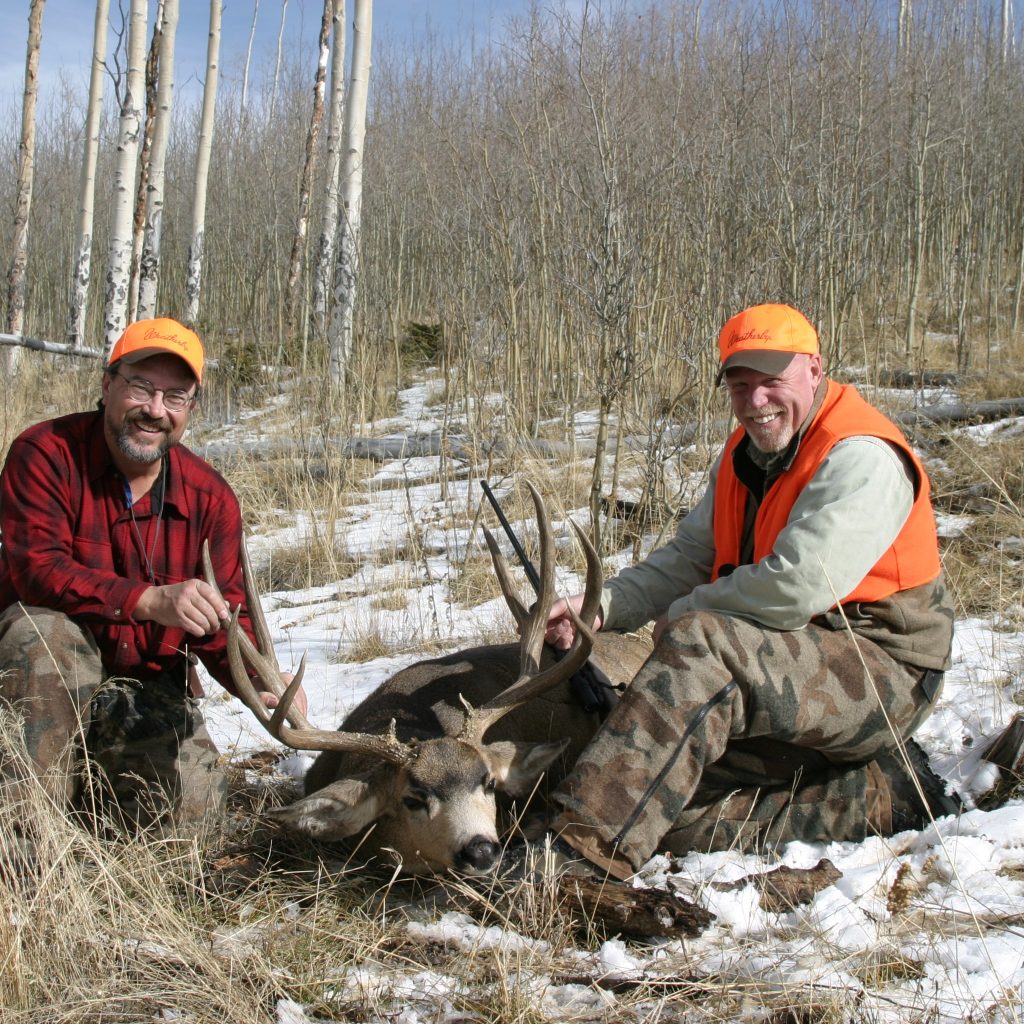
While bow hunting for elk in northern Idaho years ago, I spotted a big mule deer buck bedded far above me on a green avalanche slide, near the top of a peak only 5,500 feet above sea level. I didn’t have a deer tag, but there wasn’t any way to get in bow range anyway, since he lay in the center of the slide, amid tiny springs trickling downhill through the greenery, so didn’t need to move more than a few feet to eat or drink. (The elk were in the shady canyons far below the “high” peaks.)
There’s a limestone mountain on the east side of the valley where my wife and I live, its peak just under 9,500 feet above sea level, and you can occasionally glass mule deer bucks far up its open south slope. After first moving here 30 years ago, I started up that slope a couple times, discovering the steep scree eventually became very difficult to navigate—and would be far more difficult with pieces of mule deer buck on my back.
That was OK, however, because other exploration found a spot below that mountain where bucks often end up in November, as the rut starts and the first substantial snow usually falls. An almost level side-ridge angled southeast from the base of the mountain, around 3,000 feet below the peak, and half a mile above a small but constant creek, paralleled by a Forest Service road.
While hunting grouse along the ridge in early September we found mule deer does, fawns, and young bucks hanging out around recent clear cuts. Later we discovered the ridge was a “staging area” for both mountain bucks and elk as they started downhill after the first snows, and the closed logging road provided an easy path for sliding a plastic toboggan, loaded with big game, down to the creekside road.
On November 4th of our second autumn of hunting the ridge, Eileen and I started up the road through ankle-deep snow, looking for either elk or deer. We didn’t find anything in the first clear cut, but in the second found an older 3×3 buck, bedded toward the top of the cut amid several does. Eileen sat down behind a sawn-off stump, placed her daypack on the stump, and rested her .270 on the pack.
By then the biggest doe had gotten to its feet, then started uphill. The buck rose and followed her–but at edge of the timber paused in the classic mule deer “last mistake.” A couple hours later we tobogganed him easily down the trail. In reality, “high” mule deer country mule deer are not defined by elevation above sea level, but by living on mountains—even after they’ve started downhill to winter in the low country.
There are three primary methods of transportation when hunting high-country mule deer: horses, hiking and motorized vehicles. I have grown less fond of horseback hunting, even though horses have carried me into beautiful high country from Colorado to British Columbia. This is partly due to dislocating my left knee while loading a dead buck, when the horse decided it was time to start downhill despite the deer not being firmly tied down. I turned with the horse while holding onto the buck, but my firmly planted left foot did not. Luckily, the horse stopped and the knee popped back in, and didn’t stiffen up until after my partner and I led the horse down to the nearest road.
Horses can also kill you, though usually not deliberately, like grizzlies or Cape buffalo. My outfitter friend Richard Jackson was among the most competent horsemen—and avid mountain mule deer hunters—I’ve ever known, but died in a horse wreck before turning fifty, on his last pack-trip of the year. Horses can suddenly interrupt a mountain hunt in many other ways between dislocations and dying, especially as we grow older.
I still like to hike for mountain mule deer, but instead of trying to out-hike other hunters, these days I look for pockets they tend to pass by, especially near closed roads—and I also tend to use a game cart instead of a pack frame to bring deer downhill. This past fall I discovered one such place along the base of a narrow sandstone ridge, and am looking forward to November.
The last mountain mule deer buck I got was mostly reached by vehicle, on a hunt with outfitter Colorado Buck in the mountains of northern New Mexico. He’d leased the hunting on a private ranch, with a cabin “lodge” at a little over 8,000 feet above sea level. The deer had been hunted hard for a number of years, and the result was a lack of classic 4-point antlers. My hunting partners and I would only be allowed to take mature bucks with fewer than the normal number of tines.
I ended up hunting with a guide named Dwayne, and my old friend and fellow writer Holt Bodinson. The drill was to drive partway up one of the local 9,000-foot ridges, then hunt the ridge slowly, glassing openings. Holt had to leave early, so he got first shot—which happened on the first morning. We’d hiked to the edge of a canyon, but only found a few does, so were hiking across a near barren flat to the next overlook when Dwayne and I saw a buck walking ahead of us. His face was even grayer than usual, and the right antler a big fork, while the other appeared to be broken off short.
Holt was a little behind us, and by the time he got prone, the buck was a little over 300 yards away. At the shot the deer jumped and kicked its hind legs, then trotted 30 yards and eased to the ground. It turned out the left antler was not broken, but a short, twisted mass of short tines. Aside from the buck’s gray face, his body was also very large.
My chance came late in the afternoon the next day, when one of my friends calls “your basic mule deer buck,” with antlers spreading as wide as its ears, appeared in deer-high Gambel oak brush. But his left antler only had one fork, and luckily an opening in the brush showed the top half of his broadside shoulder. The reticle settled about 1/3 of the way down, and at the shot the buck dropped and never moved.
Even after field-dressing, Dwayne and I had something of a struggle lifting the deer into the vehicle; while not as big as Holt’s, mine still resulted in exactly 100 pounds of boned meat. It was a fine buck for all our purposes, but I was a little jealous of Holt’s ancient buck. I have been lucky enough to take a few big “typical” mule deer, but never such an old buck with ancient antlers to commemorate so many years living along the shoreline of the mule deer ocean.

